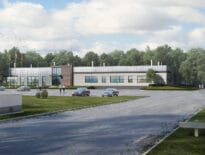The 16.5 million-square-foot redevelopment of the Suffolk Downs racetrack cleared its largest hurdle to date after an extended debate that brought to a boil concerns over housing affordability and displacement in East Boston.
The Boston Planning and Development Authority’s directors approved HYM Investment Group’s plan for 10.5 million square feet of commercial space and housing on the 109-acre Boston portion of the site.
The BDPA review spanned nearly three years and was delayed by a lawsuit alleging insufficient public outreach to non-English speaking residents, as well as restrictions on in-person meetings during COVID-19.
BPDA directors took the unusual step of scheduling a special meeting focused solely on the project, one of the largest in Boston history, with HYM Managing Director Thomas O’Brien delivering a final presentation and offering a public comment period that continued for over five hours.
The vote prompted city councilor and mayoral candidate Michelle Wu to redouble her call to abolish the BPDA.
“Imagine a Mayor & Administration where communities wouldn’t have to fight *our own city agencies* to negotiate for the public good & long-term planning,” Wu tweeted today.
District 1 City Councilor Lydia Edwards urged a yes vote, citing a series of concessions negotiated with the development team that concluded minutes before the meeting. Edwards has lobbied for more affordable units to offset rising housing prices and displacement in the neighborhood, and funding to assist residents facing eviction during the COVID-19 crisis.
“We fought for a higher floor [of affordability] than has been delivered on most projects,” Edwards said in an interview Thursday.
HYM agreed to contribute $400,000 to East Boston-based nonprofits to provide rental assistance to neighborhood residents, and the city agreed to provide an additional $400,000.
To preserve family housing availability, a minimum of 35 percent of the housing will consist of two- or three-bedroom units, a percentage that rises to 50 percent of the affordable units.
A $5 million housing stability fund administered by an independent board will be used to acquire and maintain affordable rental housing in East Boston, which would be managed by nonprofits or a land trust.
The housing built on the Boston portion of the site will include 13 percent on-site affordable units and contribute to a fund that supports development of additional affordable housing in the neighborhood, equating to 20 percent of the overall housing or 1,430 units. Edwards and local affordable housing advocates had lobbied for affordability levels as high as 50 percent of the units.
HYM’s O’Brien touted the development’s benefits including adding 10,000 units to the Boston and Revere housing inventory, up to 22,000 permanent jobs, 40 acres of open space and recreation areas, $41 million for roadwork on Route 1A and $20 million toward public transit upgrades. The estimated 18,000 construction jobs are covered by a project labor agreement negotiated with local building trades last winter.
The development also will be subject to a proposed first-in-the-nation fair housing amendment to the Boston zoning code designed to minimize displacement and discrimination caused by new projects. The final language, being drawn up by city councilors and administration officials, could result in new requirements for types of affordable units and their location on the property and income qualification levels, Edwards said.
The first 1.3 million-square-foot phase of the Boston portion of the project would be built on a 22-acre section of the property next to the MBTA’s Suffolk Downs station.









